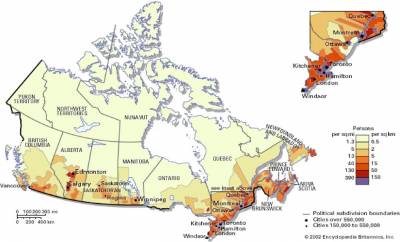
On July 1, Canada celebrated its 149th birthday. Just prior to Canada Day, I had the privilege of speaking to a group of industry professionals on the topic of the Canadian freight market during a Stifel conference call. For those of you trying to learn more about America’s neighbor to the north, this and subsequent blogs will capture the highlights from the presentation.
Canada has a population of 36.3 million people, about one tenth the size of the United States and similar in size to the population of the state of California. The majority of the population lives within a 200 mile radius of the US border, the longest unprotected border in the world. About 20 million Canadians live in the major metropolitan locations of Montreal, Toronto, Ottawa, Hamilton, Edmonton, Quebec City, Winnipeg and Vancouver. Canada has the eleventh largest economy in the world.
From a freight perspective, the country can be divided into 4 distinct regions. Each region has its own industries and transportation challenges.
Canada’s four Atlantic Provinces contain only 6.6% of the population and include Nova Scotia, New Brunswick, Prince Edward Island and Newfoundland. The major industries in this region are fishing, forestry and mining. PEI is an island that is connected to the mainland by bridge. Newfoundland is also an island that is served by ship with containers moving to this province from Montreal, QC. and Sidney, NS.
Quebec, which contains 23.8% of Canada’s population, is a unique market since many of its citizens speak French as their first language. French is the predominant language at work. Montreal and Quebec City, both on the St. Lawrence River, are the province’s largest cities. The major industries in the province are hydroelectricity, forestry, mining, aerospace and manufacturing. Many cities and towns in the province are on the south and north side of the river.
Ontario, which contains 38.5% of the population, is Canada’s most heavily populated and industrialized province. The largest freight corridor in Canada runs from Detroit, MI/Windsor, ON on the west through London (ON), Kitchener/Cambridge to Hamilton/Toronto/Oshawa through Kingston/Brockville/Cornwall, ON (on to Montreal and Quebec City, QC to the northeast). The Toronto to Niagara Falls/Buffalo, NY lane also is part of this dense freight area. Ontario is the major hub for the automotive industry in Canada. The province contains plants for 7 major auto companies. Manufacturing is also performed for a range of industries, with IT being a major component. Toronto, Ontario, Canada’s largest city, is home to many of Canada’s banks and financial institutions. Ottawa, Ontario is the capital city of Canada and host’s Canada’s federal government.
The four western provinces, Manitoba, Saskatchewan, Alberta and British Columbia, and three territories, comprise a fourth major freight area and contain 31.9% of the population. Grain, potash, livestock, oil and gas, mining and manufacturing form a large component of western Canada’s key industries. Alberta is the focal point for the oil and natural gas industries.
Here are some sample distances:
Toronto to Montreal 330 miles
Toronto to Moncton, NB 955 miles
Toronto to Winnipeg, MB 1385 miles
Toronto to Calgary, AB 2195 miles
Toronto to Vancouver, BC 2719 miles
Canada’s large size, long distances, and minimal population density, pose important challenges for transport companies in terms of a lack of freight density. Canada’s climate, which is similar to what one would experience in the New England states, must also be considered in serving the Canadian market. Montreal, Halifax, NS and Saint John, NB are key ports that have access to the Atlantic Ocean; Vancouver and Prince Rupert, BC are Canada’s two major ports that access the Pacific Ocean. In the next blog, I will examine a number of other Canadian issues (i.e. Canada – US trade, currency, customs processes, border security and legislation) that have an impact on cross-border freight transportation.
If you need assistance in serving the Canadian or cross-border market, contact me at dan@dantranscon.com. To stay up to date on Best Practices in Freight Management, follow me on Twitter @DanGoodwill, join the Freight Management Best Practices group on LinkedIn and subscribe to Dan’s Transportation Newspaper (http://paper.li/DanGoodwill/1342211466).



















